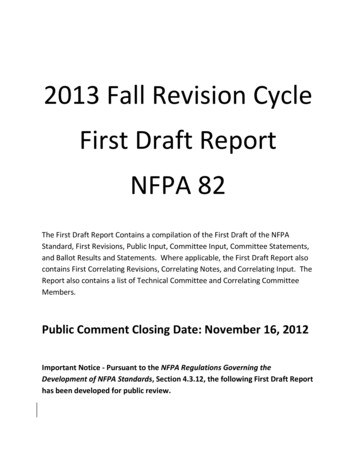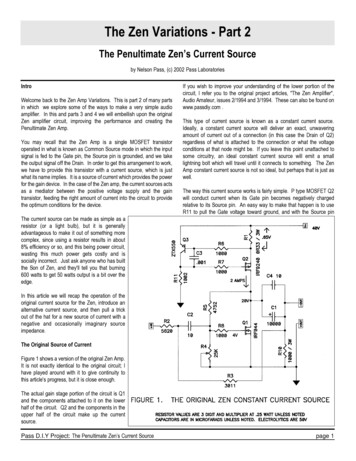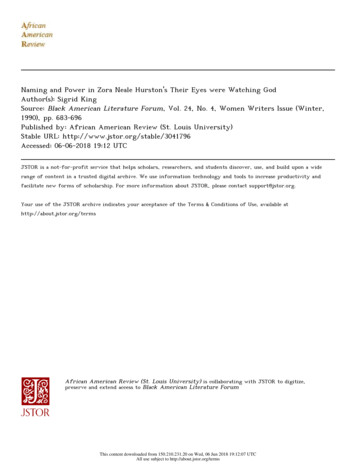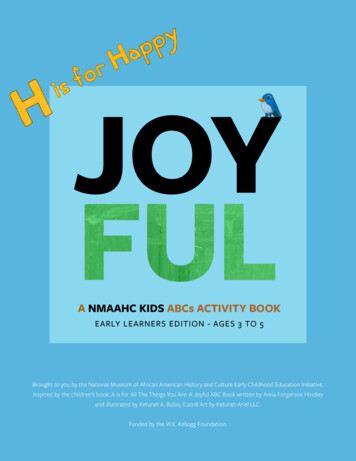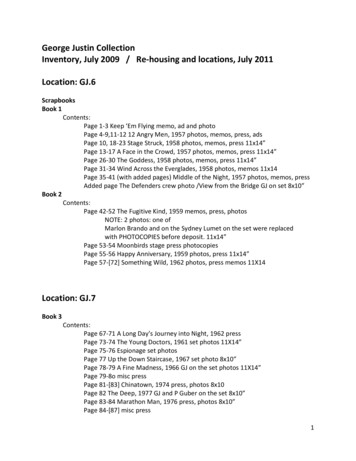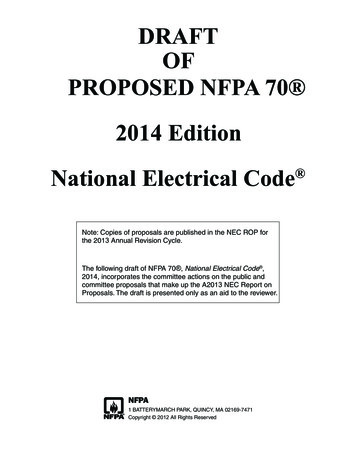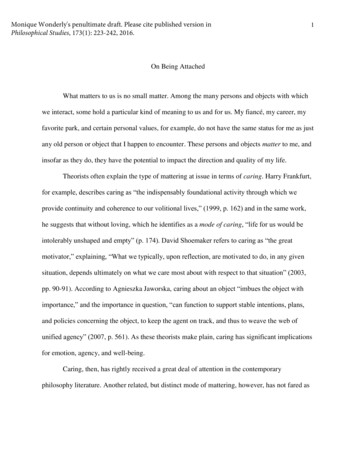
Transcription
Monique Wonderly's penultimate draft. Please cite published version inPhilosophical Studies, 173(1): 223-242, 2016.1On Being AttachedWhat matters to us is no small matter. Among the many persons and objects with whichwe interact, some hold a particular kind of meaning to us and for us. My fiancé, my career, myfavorite park, and certain personal values, for example, do not have the same status for me as justany old person or object that I happen to encounter. These persons and objects matter to me, andinsofar as they do, they have the potential to impact the direction and quality of my life.Theorists often explain the type of mattering at issue in terms of caring. Harry Frankfurt,for example, describes caring as “the indispensably foundational activity through which weprovide continuity and coherence to our volitional lives,” (1999, p. 162) and in the same work,he suggests that without loving, which he identifies as a mode of caring, “life for us would beintolerably unshaped and empty” (p. 174). David Shoemaker refers to caring as “the greatmotivator,” explaining, “What we typically, upon reflection, are motivated to do, in any givensituation, depends ultimately on what we care most about with respect to that situation” (2003,pp. 90-91). According to Agnieszka Jaworska, caring about an object “imbues the object withimportance,” and the importance in question, “can function to support stable intentions, plans,and policies concerning the object, to keep the agent on track, and thus to weave the web ofunified agency” (2007, p. 561). As these theorists make plain, caring has significant implicationsfor emotion, agency, and well-being.Caring, then, has rightly received a great deal of attention in the contemporaryphilosophy literature. Another related, but distinct mode of mattering, however, has not fared as
2well. What I will call “security-based attachment” has been largely ignored by philosophers.1 Inthis form of attachment, the agent experiences a particular object as a felt need, such that hersenses of well-being and general competence suffer without it. Unlike caring, this attitude islargely self-focused and marked by an integral connection between its object and the agent’s feltsecurity. Security-based attachment, though, has its own role to play in elucidating emotions,agency, and well-being. In this paper, I identify and articulate the key marks of security-basedattachment, and I argue that this attitude can illuminate both the specific types of relationshipthat undergird warranted grief and the particular brands of affect and agential impairmentcharacteristic of grief’s phenomenology. In other words, as I will show, philosophers’ inattentionto the phenomenon of security-based attachment is hardly benign.The paper proceeds as follows. In sections 1-4, via a series of attachment vignettesand the employment of insights from both ancient Stoicism and certain segments ofdevelopmental and clinical psychology, I put forth a view of security-based attachment. Insection 5, I distinguish security-based attachment from caring. Finally, in section 6, I arguethat attending to this distinction allows us to illuminate important aspects of grief.§1. Attachment: The CasesIn everyday discourse, we often use the term attachment to describe our emotionalconnectedness to persons and objects. Consider the parent who describes her child as attached to1While attachment has received relatively little attention among philosophers, the phenomenon does play importanttheoretical and practical roles in developmental and clinical psychology, family law, and education. I devote somediscussion to the first of these topics in later sections. Though I do not discuss the significance of attachment infamily law or education, attachment is an important factor in adoption and custody decisions (Main et al 2011) andin the development of pedagogical styles in early education (Bergin & Bergin 2009). My thanks to an anonymousreviewer from Philosophical Studies for prompting me to highlight these roles here.
3a certain toy, or the neglected spouse who complains that her husband is overly attached to hiscareer. Or again, the therapist might explain that her patient is attached to one, but not all, of hissiblings. To be sure, attachment has an important and ubiquitous presence in our lives.Surprisingly, though, the topic of attachment per se does not have much of a presence in thecontemporary philosophy literature.2 Here, I address this lacuna by identifying a particular groupof characteristics as one form of attachment and illustrating how those characteristics constitutean interesting, unique, and fruitful source of philosophical inquiry.The brand of attachment in question will ring familiar to most, as it is instantiated acrossa variety of relationships and contexts that we frequently inhabit. To see this, consider thefollowing vignettes:(1) Loving Leslie. Leslie and Thomas have been married for 30 years, and their bond isvery strong. Leslie thinks of Thomas frequently, hopes that his business meetings gowell, worries if he forgets his umbrella on a cloudy morning, and though she cares littlefor sports, takes joy in the success of his fantasy baseball team and his good showing atthe local golf course. She refers to Thomas as her “rock.” When upset, she turns to himfor emotional support. Leslie feels much better – indeed more capable – when he isnearby. In fact, when they are separated for long periods, even while she spendssignificant time amongst friends, her physical health often seems to suffer.(2) Running Riley. Riley is an avid runner. He reads running magazines, participates ininternet chat groups for runners, and delights in planning his morning run each day. Hecarefully chooses a scenic route, picks out the perfect shoes for the terrain, and selects themusic playlist that will best enhance his running experience. When Riley runs, he feelsfree and empowered. And when he misses his morning run, he often becomes uneasy,noting that he doesn’t feel “quite together.” When he has a tough day, Riley often feelsthe need to go for an additional evening run in order to “regain his bearings.” No otherexercise or activity will do.2To my knowledge, there has been no sustained analysis of attachment in the philosophy literature. Theorists,however, have employed the term in discussions of emotions (Moll et al 2008, Roberts 2003, Solomon 2001,Brentlinger 1989), psychopathy (Kennett 2002, McGeer 2008, and Watson n.d.), and the tension between certainrelationships and the moral demand for impartiality (Herman 1991 and Feltham 2011). In the first chapter of Value,Respect, and Attachment, Joseph Raz (2001) does not clearly define attachment, but he offers some interestinginsights on how attachment relates to value and personal meaning. In Emotions, Robert C. Roberts (2003) suggeststhat attachment plays a role in certain emotions, and he describes it variously as liking (p. 130), caring (p. 143), andas “a special kind of concern” that is “especially relevant to one’s self-concept” (p. 260).
4(3) Blake’s Blanket. When Blake was 18 months old, his mother bought him a fluffy, redblanket. Now two, Blake rarely goes anywhere without it. It’s the first thing he looks forwhen he wakes. He refuses to let his mother wash it – insisting that it’s his and he likes ithow it is. When scared or hurt, he clutches the blanket especially close, and if it is notnearby at the time of his fear or injury, he is downright inconsolable. Once, his motheroffered him a virtually identical blanket instead, but he vehemently rejected it. On hisfirst day of pre-school, Blake stood shyly in the corner, refusing to interact with the otherchildren until his mother retrieved his blanket from the car.(4) Obsessed Olivia. Olivia works for the local grocer, along with her co-worker, Tim.Though they’ve only spoken briefly, Olivia often fantasizes about lengthier interactionswith Tim. She watches him while working, invents reasons to be nearer to him, and evenhangs around the store on her days off just to be close by. Olivia covertly took a pictureof Tim, explaining that when she doesn’t see him for a while, she becomes depressed, butlooking at his photo helps her get through the day. Upon learning of his intent to apply toan out-of-state college, she sabotaged his application claiming that she “needs himaround” as he’s the only thing that can keep her going.Admittedly, what is perhaps most striking about these vignettes are the different relationshipsfeatured among them. Leslie loves Thomas. Riley has a passion for running. Like many toddlers,Blake has developed an affinity for a soft, cuddly object. Finally, Olivia’s feelings and behaviorsare pathological; she is obsessed with Tim. Despite their differences, however, I want to suggestthat all of these cases exemplify a particular form of attachment. In other words, whatever else istrue of these vignettes, the main characters are all attached: Leslie is attached to Thomas, Rileyto running, Blake to his blanket, and Olivia to Tim. Now the task at hand is to specify thosefeatures in virtue of which the attachment relations obtain.§2. Attachment and Felt NecessityThus far, I have suggested that each of the primary vignette characters is attached to someperson or object. Yet, the question remains: What is it about their respective relationships thatwarrants the label of attachment? In other words, what does it mean to be attached? Over the
5next three sections, I provide an answer to this question. I will begin by highlighting a pair ofcharacteristics that I take to be (partially) constitutive of attachment: characteristics that havebeen associated with attachment at least as far back as the ancient Stoics. Let me explain.Though the ancient Stoics do not clearly define attachment, theorists working in thistradition are well-known for admonishing their followers against it. This admonition followsnaturally from the fact that an important ideal in the Stoic conception of the good life is apatheia,commonly translated as “freedom from passions.”3 Patheia, derived from the Greek pathos, doesnot represent passion in the term’s ordinary sense, but rather it incorporates both the notions offeeling and suffering.Many passages in the Stoic corpus reflect high praise for apatheia. Among the mostpopular examples is Cicero’s expressed approval of Anaxagoras in his Tusculan Disputations.Cicero writes, “Anaxagoras, on receiving news of his son’s death, was reported to have calmlyobserved, ‘I was already aware that I had begotten a mortal’” (Cicero 1887, 3.30). Similarly,Epictetus instructed,Whenever you are getting attached to someone, don't let it be as though they're somethingundetachable - but more as if you had a jar or a crystal goblet, so that when it breaks,you'll remember that it's that sort of thing and not be upset. In the same way, remindyourself that the person you love is mortal, not one of your own possessions, somethinggiven to you for the present, not undetachably nor forever, like a fig or a cluster ofgrapes, in the due season of the year - and if you hanker for that in winter, you're a fool.If you long for your son or your friend like this, at a time when that has not been given toyou, rest assured: you are hankering for a fig in winter.4 (Epictetus 3.24)In denouncing attachment, I take it that neither Cicero nor Epictetus mean to advocate theabolition of all cares. Recall that apatheia indicates the absence of passion (patheia), not caring.3See for example Keith Seddon’s (2005) introduction to Epictetus’s Handbook.The term translated as “attached” is a conjugated form of “prospaschein” (προσπάσχῃ ς). This is a compoundword, consisting of the prefix “pros-” (meaning “toward”) and the verb “paschein” which has the same root as thenoun “pathos” (the state of “feeling” or “suffering”).4
6Presumably, both would maintain that a father should care about his son. However, they wouldalso maintain that a father ought not to subject himself to undue suffering by desiring his son’spresence when it is no longer attainable.5 On the terminology I favor, we might say that theancient Stoics mean to discommend “patheiac desires,” desires that subject one to suffering whenleft unsatisfied.6The ancient Stoic view highlights two important elements of the kind of attachment thatI’m concerned with: First, such attachments are characterized in part by strong desiresconcerning the attachment object, and second, we are prone to suffering when we are deprived ofour attachment objects.7 Notice that this coupling of features is present in each of the vignettes.Leslie desires Thomas’s active presence in her life, and when they are separated for prolongedperiods, she begins to feel unwell. Riley wants to run, and when he cannot, he tends to feelunbalanced or unsettled. Blake seeks to hold and cuddle his blanket, and when it is not on hand,he is easily agitated and upset. Olivia craves interaction with Tim, and when the prospect of suchinteraction is threatened, she is beset by frustration and sorrow.5This echoes Dirk Baltzy’s point (2010) when he writes “ the view that one should be ‘apathetic,’ in its originalHellenistic sense, is not the view that you shouldn't care about anything, but rather the view that you should not bepsychologically subject to anything—manipulated and moved by it, rather than yourself being actively andpositively in command of your reactions and responses to things as they occur or are in prospect.”6This notion, or something like it, also seems to have purchase in certain strands of Buddhism and Daoism. Theearliest Buddhist teachings held that all life is suffering because we are attached to, or desire, worldly things, andsuch attachments inevitably lead to suffering. See for example, the Digha Nikaya (DN 31, 5; DN 34, 2.2, 4).Zhuangzi, one of the earliest exponents of Daoism, argued that in order to achieve a tranquil mind, one must bedelivered from attachments (Graham 1981). The Daoist view of attachment is similar to that of the Buddhist’s. BothBuddhists and Daoists equate patheiac desires with suffering, and while Buddhists view relief from suffering as anend in itself, Daoists take issue with attachment because the emotional disturbance caused by patheiac desiresinterferes with the achievement of internal tranquility and harmony with the universe (Kupperman 2001, p. 121).7One might think that any desire, if sufficiently strong, leaves one prone to suffering. As Frankfurt (1999) pointedout, however, many of our desires – even strong ones – seem to pass without much note. This typically occurs incases in which we do not feel as though we will be harmed in any way by going without the desired object.
7These two elements, the desire and the ensuing distress when the desire is left unsatisfied,bring to the fore the sense of need integral to attachment. Roughly, to need something is to besuch that one would be, in some sense or another, harmed without it.8 One can, of course, bewrong about what one actually needs. I might need something and fail to realize it, in which caseI might have no desire for it whatsoever. Or again, I might feel as though I need something whenI, in fact, do not really need it. In the latter case, I nevertheless experience the object as a feltneed. The experience has a powerful conative structure. I feel drawn toward the object, andtypically, I have strong desires concerning it. In virtue of (what I feel as though is) my need forit, I am tugged this way and that.Generally, we experience our attachment objects as felt needs. This does not imply thatwe are, in every case, (all things considered) better off with than without our attachment objects.Yet, part of what it means to be attached to an object is to have strong desires concerning it andto feel as though one would suffer some measure of harm without it. One might be attached to aremorseless, abusive spouse, for example. All things considered, the spouse detracts from theattached party’s actual well-being; yet, even while she fears being near him, insofar as she isattached, she will desire certain kinds of interaction with him, and in an important respect, feelworse when that interaction does not occur. This brand of ambivalence might explain why somepeople continue to remain in abusive or otherwise deleterious attachment relationships. Evenwhen one’s attachment object is inimical to her well-being, there is a sense in which she justdoesn’t feel all right without it.8See for example Harry Frankfurt (1999) and David Wiggins (1998).
8Experiencing someone or something as a felt need is a central feature of the form ofattachment at issue in this paper. This, however, is not the whole of it. In attachments of therelevant sort, one’s felt need for an object involves a particular kind of desire and a particularkind of harm when that desire is left unsatisfied. Let’s begin with the desire.§3. Engagement with a Non-Substitutable ParticularOn my view, attachments involve a relatively enduring desire for engagement with a nonsubstitutable particular. A similar desire has been associated with attachment before. To see thisthough, we turn not to the ancient Stoics, but to contemporary developmental and clinicalpsychologists.After volunteering at a school for maladjusted children in the late 1920’s, Britishpsychologist John Bowlby hypothesized a link between early family relationships andsubsequent emotional disturbance and deviant behavior in children. Over the next 60 years, he,along with his colleague Mary Ainsworth, pioneered the development of what is now called“attachment theory.”9 According to attachment theory, between six and twenty-four months ofage, infants develop a special bond with their primary caregivers. This bond is characterized interms of a set of evolutionarily adaptive behaviors that serve to provide the infant with a sense ofsecurity. As Bowlby explains, the attached infant attempts to remain in close proximity to herprimary caregiver, treats her as a “secure base” from which to safely explore unfamiliarsurroundings, seeks her out for protection as a “safe haven” when threatened or hurt, and protestsseparation from her – e.g., via clinging, crying, and other displays of distress (1969/1980).9For more on the development of attachment theory, see Ainsworth (1969) and Bowlby (1969, 1973, & 1980).
9Interestingly, though infants learn early on that many different individuals (e.g., daycareworkers, other relatives, etc.) are capable of tending to their basic needs, the pattern ofattachment behaviors enumerated above is directed specifically toward the primary caregiver.Furthermore, the bond tends to remain even when the primary caregiver is inept at properlycaring for the infant. Once attached, even while she accepts some care from others, the infantcontinues to need her specific attachment figure(s) – no substitute will do. Even while beingprovided for by others, prolonged separation from her primary caregiver typically results insevere distress. In Ainsworth’s words, “ an attachment figure is never wholly interchangeablewith or replaceable by another ” (1991, p. 38).10From the above picture, it is clear that on the Bowlby-Ainsworth view, attached infantsdesire proximity to a specific, non-fungible person.11 Much like the infant primary-caregiverbond, attachments of the type I aim to illuminate here involve a desire for something likeproximity to a non-substitutable particular individual. Recall the vignettes. Leslie seeks to benear Thomas and also to receive a kind of support that he alone can provide her. In an admittedlyvery loose sense, Riley desires to be nearby when running is taking place, but of course, morespecifically, he wants to be the one doing the running. For him, no comparable activity orexercise will do. Similarly, Blake longs to be near – and to cuddle with – his blanket. He rejects10For more on this point, see Bowlby 1969, pp. 308-309; Bretherton 1991, p. 19; Weiss 1991, p. 66; Mikulincer &Shaver 2007, pp. 57-58; Cassidy 2008, pp. 12-15.11Notably, while psychologists have traditionally tended to reserve the term attachment for the infant-primarycaregiver bond, the Bowlby-Ainsworth model has been, with some modification, extended to adult romanticpartnerships as well. See for example Hazan & Shaver 1987, Rholes & Simpson 2004, Brumbaugh & Farley 2006,Hazan et al. 2006, and Mikulincer & Shaver 2007. Even Bowlby, himself, though essentially concerned toinvestigate the infant-primary caregiver bond, suggests that attachment extends across one’s lifespan, taking theform of romantic relationships and other pair bonds in adulthood (1980). Views on which childhood and adultfriends sometimes function as attachment figures are now more common in the psychology literature, though thisdomain of attachment has received little attention compared to infant-primary caregiver and romantic relations (SeeMikulincer and Shaver 2007, esp. chp 1-3). It is far rarer to find attachment-theoretical frameworks that countenanceinanimate objects and ideas as genuine attachment objects.
10all attempts to replace it, even with a virtually identical one. Finally, Olivia enjoys being nearTim and is ultimately after a deeper sort of interaction with him – conversation, more intimatephysical contact, etc. And here again, it is clear that she seeks such interaction with Tim inparticular; directing her affections toward another unfortunate coworker instead is simply not anoption for her.Importantly, the above descriptions reveal not only certain similarities between (thedesires at play in) the Bowlby-Ainsworth model and the type of attachment I am concerned withhere, but they also reveal subtle differences. First, notice that the non-substitutable particular inthe Bowlby-Ainsworth model represents a person, i.e., the primary caregiver. As the vignettessuggest, however, the type of attachment at issue in this paper extends not only to persons, but toinanimate physical objects (Blake’s blanket) and even to ideas and activities (Riley’s running).Arguably, the two types of attachment also diverge on precisely what it is that theattached party wants from (or with) the non-substitutable particular. For example, Bowlby andAinsworth emphasize the infant’s tendency to seek proximity to her primary-caregiver. As Iindicated above, the vignette characters all desire “something like” proximity to their attachmentobjects, but it seems more accurate to say that they desire engagement with them.12 For Leslie,Riley, Blake, and Olivia, simply being near their respective objects and persons isn’t quiteenough. Leslie wants to share her life with Thomas. Blake wants to hold his blanket. Oliviadesires, inter alia, to converse with Tim. And while the notion of proximity to running seems12Interestingly, attached infants typically seek more than mere proximity as well. Everyday experience – and evenparticular aspects of the Bowlby-Ainsworth model – seem to suggest as much. Infants want their primary caregiversto hold and play with them. They search for cues that it is okay to explore new environments, such as the mother’sreaffirming “Go ahead – it’s okay” gesture. They want to be picked up and comforted by their primary caregiverswhen feeling threatened or hurt. Also, a desire for engagement, as opposed to mere proximity, is especially salient inadults’ attitudes toward their attachment objects. Attached adult romantic partners, for example, desire sexualcontact, conversation, and other sorts of playful or otherwise stimulating interaction with one another.
11strained, engagement with an activity seems far less so. Riley engages with his attachment object– the activity of running – by doing it, i.e., by running.13§4. Attachment and SecurityAbove, I used the Bowlby-Ainsworth model to help explain the desire defining of (therelevant sort of) attachment: it is a relatively enduring desire for engagement with a nonsubstitutable particular. I will now show how this model can also help to elucidate the specifictypes of harm and benefit to which we are subject in light of our attachments. Ultimately, Isuggest that the attached party’s sense of security undergirds the relevant types of harm andbenefit.Recall that Bowlby and Ainsworth employ the notion of security to explain the infantprimary caregiver bond. On their view, the infant engages in a specific pattern of behaviorstoward her primary caregiver in order to maintain or restore her felt security. As it is not aunivocal term, at first glance, it is not clear what phenomenon they mean to pick out by“security.” On the one hand, they sometimes seem to point to something akin to safety. In fact,Bowlby explicitly associates “security” with a “feeling of safety” (1969, p. 374; 1973, pp. 182183). To be sure, “security” often connotes safety, and this understanding of the term seemsparticularly apposite in the case of attached infants. Infants want to be near their primarycaregivers, in part, because being close by allows them to feel safer. And they use their primarycaregivers as secure bases and safe havens in order to mitigate potential or actual threats to theirsafety. This understanding also makes sense of the phenomenology and etiology of attachment13Likewise, one can engage with an idea – e.g., the concept of infinity – by contemplating it.
12behaviors in infants. Generally, an awareness (suspicion, feeling, etc.) of danger triggers andintensifies an infant’s attachment behaviors, and as such behaviors often conduce to securingsafety against predators and other threats, they tend to increase reproductive fitness.On the other hand, there are understandings of security that are not restricted to thesimple notion of safety, and sometimes, Bowlby and Ainsworth point to those as well.Ainsworth, for instance, drawing on the term’s etymology, suggests that a good workingdefinition for feeling secure is being “without worry” or “free from insecurity” (1988, p. 1).14 Inthe same paper, she also speaks approvingly of a conception of security that she gleaned fromBowlby’s later work: security as “an ‘all is well’ kind of appraisal of sensory input,” or “an‘Okay, go ahead’ feeling” (ibid). This conception of security, while not unrelated to feeling safe,calls to mind a richer affective experience.15To see this, consider how other psychologists have described security. Abraham Maslowcharacterized security as a “syndrome of feelings,” that includes, inter alia, feelings of “being athome in the world,” “emotional stability,” “self-esteem,” “self-acceptance,” and “courage”(1942, pp. 334-335). William Blatz, in developing his “security theory,” identified security as“the state of mind which accompanies the willingness to accept the consequences of one’sacts ” (1966, p. 13). According to Ainsworth, Blatz, who had been her dissertation advisor,“seemed to equate feeling secure with feeling competent or effective” (1988, p. 1). Drawing onthese views, security might be construed, roughly, as a feeling of confidence in one’s well-beingand in one’s ability to competently navigate the world. As I will show, it is this sense of14Security is derived from the Latin “se-” “cura,” and literally translates as “free from care.”Bowlby may mean to capture no more than a feeling of physical safety here, but as will be clear, I use the term ina broader sense. I also leave room for the possibility that the sense of security at issue in this paper does notsubstantially differ from that of the Bowlby-Ainsworth view.15
13security, as opposed to the notion of mere safety, that explains the particular type of harm – andrelatedly, a particular sort of benefit – that we are subject to in light of our attachments.While an infant might feel simply unsafe when separated from her attachment object, aswe get older, we develop richer senses of self that can be upset in more complex ways. Forinstance, an adult undergoing extended separation from her attachment object might feel asthough she is “out of sorts,” “off-kilter,” “no longer all of a piece,” and so forth. Likewise,engagement with an attachment object might allow her to feel as though “she is on solidground,” or more competent. These descriptions, while admittedly colloquial, are not vacuous;rather they capture something very real about the emotional lives of human beings.Let’s return to the vignettes. Notice that in each case, prolonged separation from theattachment object results in the agent feeling significantly worse off and less competent to getalong in everyday affairs, i.e., less secure. Leslie, for example, becomes anxious, even to thepoint of physical illness, on account of Thomas’s extended absence. Riley feels uneasy and “lesscentered” when he hasn’t run for a while. Without his Blanket nearby, Blake becomes easilyfrightened and unable to engage with others in new environments. And when denied theopportunity to interact with Tim, Olivia feels impaired, unmotivated, and depressed.Conversely, by engaging with the relevant person or object, Leslie, Riley, Blake, andOlivia each experience a sense of increased confidence in his or her well-being and in his or herability to navigate the world – in other words, an increased sense of security. Leslie, for example,doesn’t simply feel better when engaging with Thomas, but she feels “more together” – asthough she is “on stable ground.” Likewise, running empowers Riley, allowing him to, amongother things, “regain his bearings” in the face of adversity. Similarly, Blake clutches his blanket
14especially close in order to feel okay again when his safety is threatened, and when he has it inhand, he feels more enabled to explore unfamiliar surroundings. Finally when engaging withTim, Olivia feels more capable – as though she is “better equipped” to face her daily activities.We are now in a position to succinctly articulate the core features of the relevan
See for example Keith Seddon's (2005) introduction to Epictetus's Handbook. 4. The term translated as "attached" is a conjugated form of "prospaschein" (προσπάσχῃς). This is a compound word, consisting of the prefix "pros-" (meaning "toward") and the verb "paschein" which has the same root as the .
